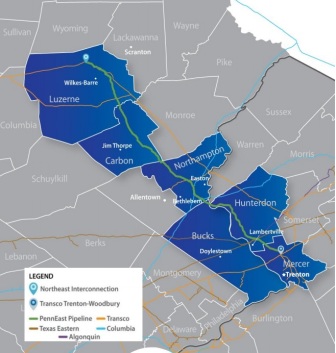An executive with PennEast–the regional energy conglomerate that hopes to build a 114-mile, 36-inch natural gas pipeline in Pennsylvania and New Jersey–told members of the Greater Lehigh Valley Chamber of Commerce’s boards of directors Monday that the gas that will potentially be piped through the Lehigh Valley is intended for domestic use.
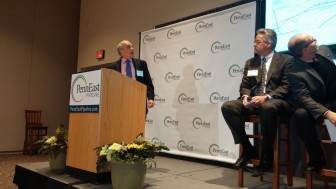
Chairman of the PennEast Pipeline board of managers Peter Terranova (at podium) discusses the proposed natural gas pipeline before Greater Lehigh Valley Chamber of Commerce members.
“I’d say the answer today is it’s going to be used here,” said Peter Terranova, chairman of the PennEast Board of Managers, in response to a question from an audience member. “It’s going to be used in Pennsylvania and it’s going to be used in New Jersey.”
He asserted that there is “more than enough demand” in the region to warrant the construction of the pipeline, and a slide that was displayed at the event stated that “the pipe is being built to reduce the cost of natural gas and electricity to eastern PA and New Jersey businesses.”
Pipeline opponents have questioned both the level of demand and the final destination for the gas, and as recently as last Wednesday an environmental attorney representing Lower Saucon Township did so during a discussion about the current Federal Energy Regulatory Commission (FERC) scoping process.
Lower Saucon Township last month became one of several eastern Pennsylvania municipalities to adopt resolutions opposing the pipeline, which opponents fear could devalue properties, as well as cause health and safety problems. Proponents argue that it could be a boon for the region’s economy.
Economic benefits cited in a recently-released study commissioned by PennEast were the focus of the presentation Monday by Terranova, who is also vice president of Midstream Services, UGI Energy Services Inc.; Stephen P. Mullin, president and principal of Econsult Solutions; and Paul Jensen, associate dean for graduate and undergraduate programs at Drexel University’s LeBow College of Business.
Econsult Solutions and the Drexel University School of Economics prepared the study, which includes the following statement in its Conclusion:
We forecast the PennEast Pipeline Project to generate a significant positive economic impact in Pennsylvania and New Jersey, increasing economic activity and supporting new jobs. Construction and ongoing operations of the Project will be economically beneficial to the counties in which the pipeline will traverse and both states as a whole. In addition, the possibility for increased income derived from potentially lower energy bills could induce spending in the regional economy and spur an even broader and larger impact.
According to a one-sheet accompaniment given to meeting attendees, it is estimated that building the pipeline will pump $1.62 billion in construction and labor costs into the economies of Pennsylvania and New Jersey, create more than 12,000 jobs and “spur $730 million in indirect and induced impacts” in both states.
Mullin cited vendor spending along the pipeline route as an example of indirect spending, and the money earned by employees that’s put back into the economy via their individual spending as an example of an induced impact.
He estimated that the ongoing operation of the pipeline will generate $23 million in annual economic revenue and support more than 100 jobs.
Mullin said the models he used to predict the pipeline’s economic impact “don’t go deep enough to estimate the very fine line on (the potential impact on taxes),” but the study states that the pipeline “will lead to increased economic activity, employment and tax revenues.”
GLVCC Energy and Environment Committee chairman John Hayes noted that the chamber as a whole has not adopted an official position on the pipeline.
If it does adopt a position, one way or another, there is four-step process Hayes called “inclusive” that must be followed that ends with a decision by the chamber’s board of governors.
“Anything that we come out with has been very thoroughly reviewed and makes sure it’s in the interest of our chamber members,” he said.
One concern in the Lehigh Valley has been the route of the proposed pipeline, which has not been finalized, but Terranova said PennEast is responding to locational concerns as they arise.
He cited movement of the route away from St. Luke’s University Hospital’s Anderson Campus in Bethlehem Township–in response to the hospital’s concern–and when asked about a route that could bring it close to a nearby housing development, he commented, “that would be a bad place to run a pipeline.”
“I’m sure that’s being looked at,” he said.
Even though PennEast won’t sell gas directly to consumers, construction of the pipeline “can only help” to lower the cost of natural gas in the Lehigh Valley and other areas near it because “it increases gas-on-gas competition within the UGI service territory,” Terranova also said.
Interconnections along the pipeline that will benefit consumers are currently being developed, and details about the connections should be available within a matter of months, he added.
If PennEast receives the regulatory approvals it needs to commence building the pipeline, it is estimated that construction will last eight to nine months, with transportation of natural gas beginning in 2017.
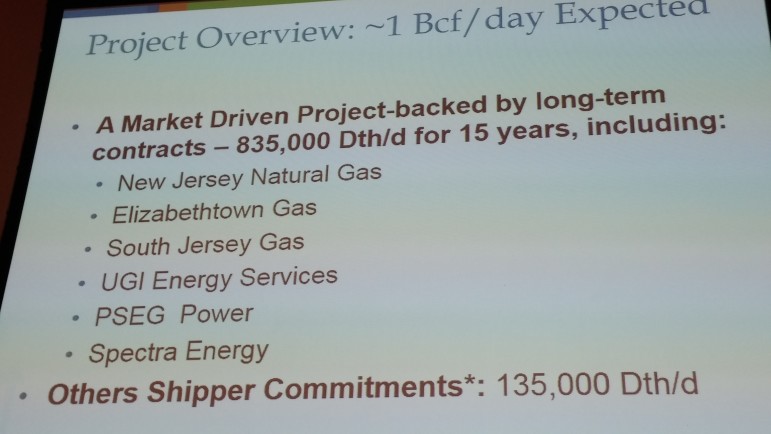
A slide outlining the impact of the proposed PennEast natural gas pipeline is displayed at a Feb. 23, 2015 meeting of Greater Lehigh Valley Chamber of Commerce directors.
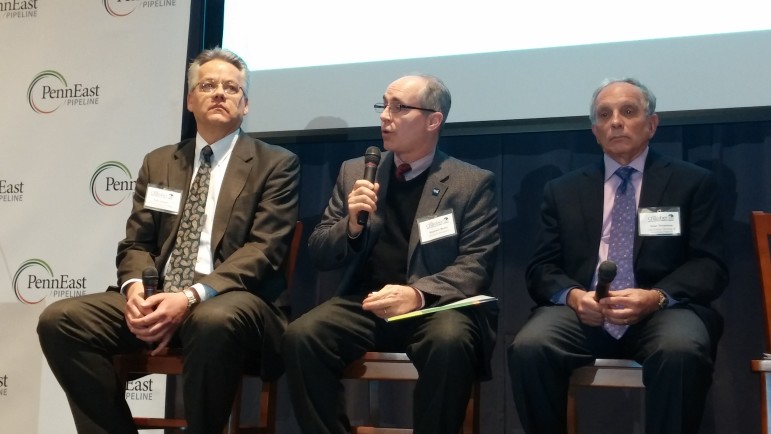
From left, associate dean for graduate and undergraduate programs at Drexel University’s LeBow College of Business Paul Jensen; President and principal of Econsult Solutions, Stephen P. Mullin; and chairman of the PennEast Pipeline board of managers Peter Terranova
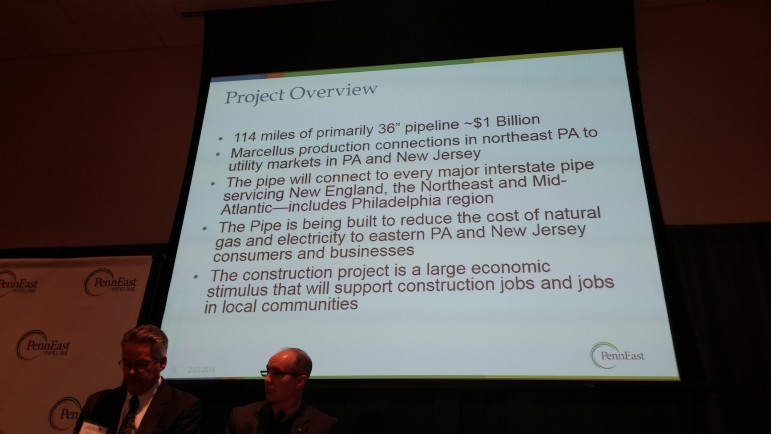
A slide presents an overview of the proposed PennEast natural gas pipeline project in Pennsylvania and New Jersey


